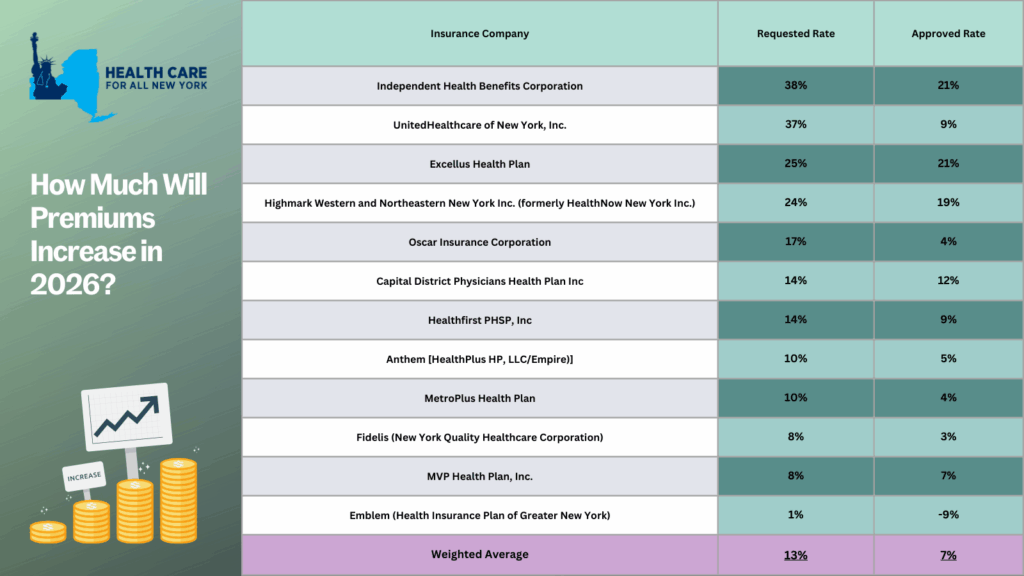Covered California enrollees may see their rates increase in 2026 by an average of 10.3%, the largest increase since 2018. However, that number does not reflect the impact on consumers: 1.7 million enrollees in California could see an additional average net premium increase of 66%, from the loss of enhanced federal premium tax credits. Consumers have […] The post Covered California 2026 Rates Released appeared first on Health Access.
- Covered California enrollees may see their rates increase in 2026 by an average of 10.3%, the largest increase since 2018.
- However, that number does not reflect the impact on consumers: 1.7 million enrollees in California could see an additional average net premium increase of 66%, from the loss of enhanced federal premium tax credits.
- Consumers have been insulated from modest rates over the last few years due to the Biden Administration’s investment in premium affordability assistance which expires at the end of the year. Republican leaders in Congress have failed to take action to extend it.
- Enrollees can see just how much more they will be paying for premiums, deductibles and co-pays starting mid-October, ahead of an open enrollment period that has been shortened by the Trump Administration, that will begin November 1 and end December 31.
SACRAMENTO, CA – Covered California, the state’s health care insurance marketplace, today announced a 10.3% premium rate increase for 2026 – the largest rate increase since 2018. But the real impacts will be how much more premiums will cost for consumers – skyrocketing on average 66% for almost all enrollees if Congress does not take immediate action. This premium spike is largely due to uncertainty in the health care system from the looming end of federal financial help for consumers to afford their coverage. California is facing a loss of $2.1 billion in federal funding that has been used to help lower the cost of coverage for the nearly 2 million Californians enrolled through Covered California.
Investments from the Biden-Harris Inflation Reduction Act (IRA) – built upon affordability assistance already in the Affordable Care Act – capped health exchange plan premiums at 8.5% of income and often much less for those with lower incomes. This enhanced premium help from the IRA is set to expire at the end of this year. Yet even with the coming increase in health care costs for Californians and their constituents, Republican leaders in Congress and the Trump Administration have failed to act to make these subsidies permanent.
“After running on a platform of addressing the rising cost of living, Republicans in Congress and the Trump Administration are now directly responsible for spiking the cost of health insurance for millions of Californians. California Republican Congressmembers like David Valadao and Young Kim could have stood up for their constituents and stopped these premium spikes, but they have failed to do so,” said Amanda McAllister-Wallner, Executive Director of Health Access California. “Their lack of action will cause the largest ever increase in health care premiums for Covered California enrollees and will lead to hundreds of thousands of Californians losing their coverage, forcing them to take on greater debt to afford their care – or skip care all together.”
Many Covered California enrollees will also be facing a double whammy of premium increases along with higher out-of-pocket costs. Over the last few years, California has been able to take steps in our state budget to lower deductibles and co-pays for tens of thousands of enrollees. But that money may need to be clawed back to help backfill the loss of federal funds. The state has allocated $190 million to help cushion the blow for the lowest income enrollees, but many Californians will face the return of $5,000 deductibles and higher co-pays for things from labs, x-rays, generic prescription drugs, and more.
Covered California has previously estimated that as many as 660,000 Californians could lose coverage due to increased red tape and higher costs. Over 100,000 of those that will lose coverage live in districts where their Republican Congessmember voted for H.R. 1, a bill that did not include any help to afford coverage, and in fact leads to higher costs and more people uninsured.
Last month the Trump Administration also changed their policy for DACA enrollees who purchase coverage through Covered California, barring them from doing so after this month. This will directly lead to another 2,400 Californians either going uninsured or paying much more for their care.
The Trump Administration and Republicans in Congress have also put up more barriers to enrollment in Covered California, adding to consumer confusion. H.R. 1 shortens the usual 3-month open enrollment period to just 2 months, starting on November 1 and ending on December 31 when many families are likely to miss the deadline. The use of auto-enrollment which helps many families stay covered, will also end.
For a more detailed list of the impacts on marketplace coverage from H.R. 1, please see this new factsheet from Health Access: The State of Health Care Coverage.
Consumers will be able to begin estimating their premium, deductible, and co-pay cost impacts by logging into their Covered California accounts starting in mid-October.
| Press inquires can be directed to:
Rachel Linn Gish, rlinngish@health-access.org |
The post Covered California 2026 Rates Released appeared first on Health Access.











